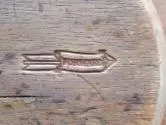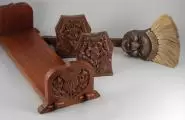“We Came as Tourists”

It was a humble beginning for two humble women.
In 1901, thirty-two year-old Eleanor Vance and thirty-one year-old Charlotte Yale, two recent graduates of Moody Bible College, stepped off the Southern Railway train in Biltmore Village, a small cluster of Arts and Crafts cottages being built by George Vanderbilt for the 800 employees needed to run his 146,000-acre Biltmore Estate outside of Asheville.
Eleanor Vance had spent nearly nine years learning to be a woodcarver at the Cincinnati Arts School before enrolling at Moody, while Charlotte had attended Oberlin College, 200 miles to the north. The two young women met at Moody in Chicago, where they became involved with the settlement house movement led by activist reformer Jane Addams, who befriended the pair. Eleanor and Charlotte immediately became lifelong companions, and hoped to journey to India as Presbyterian missionaries.
But the duo had also assumed responsibility for Eleanor’s mother, whose declining health forced them to adjust their plans and instead move south, first to Florida and then to North Carolina. In Biltmore Village they rented a house from Vanderbilt’s agent, and there Eleanor resumed her woodcarving on their open back porch, and soon attracted a curious group of young boys living nearby.
The rector at Vanderbilt’s All Souls Church quickly recruited Eleanor and Charlotte as Parish Workers, and the three formed both a Boys’ Club and a Girls’ Club, Eleanor teaching woodcarving to the boys and Charlotte showing the girls how to sew and embroider. In 1905, with the financial support of Edith and George Vanderbilt, their clubs combined to form Biltmore Estate Industries with the goal of providing the youth in the village valuable skills they could use to earn a living.
While Eleanor Vance had been trained in the late-Victorian style of woodcarving, she and Charlotte embraced the Arts and Crafts philosophy of handcraftsmanship, along with designs inspired by nature. Each month they read the latest issue of Gustav Stickley’s The Craftsman magazine, and even made oak tea tables based on plans published by Stickley.

Biltmore Estate Industries, however, established its reputation on the hand-carved bowls, bookends, trays, picture frames, bellows and hearth brushes tourists who wandered into their small showroom could easily take home with them (scroll up to top picture). They worked primarily in walnut, for it was more suited to deep intricate carving than was oak. But the designs which Eleanor Vance drew for their young carvers were inspired by the native flora, including dogwood blossoms, galax leaves, and trailing grape vines. And as each piece was completed, they followed Stickley’s example of stamping their shopmark — an arrow with the word “Forward” — on the underside (pictured).
Their work traveled with tourists across the country and today has developed a growing number of collectors. Two examples of their work have been included in an exhibition currently on display at the Asheville Art Museum, “Appalachian Innovators: Women Makers in the Southern Highland Craft Guild, 1930-2000,” which will be on display until July. For those of you around Asheville curious about their work, I will be giving a brief talk about my two favorite Arts and Crafts women this coming Friday, May 20th, at the downtown Art Museum’s noon “Art Break.” Admission is free for members or with a paid admission to the Art Museum.
Stop by and you’ll come away with a new appreciation for two talented but humble Arts and Crafts women who made a difference in the lives of hundreds of young men and women.

Until next Monday,
Recipe for Happiness: Be Kind. Repeat.
Bruce
